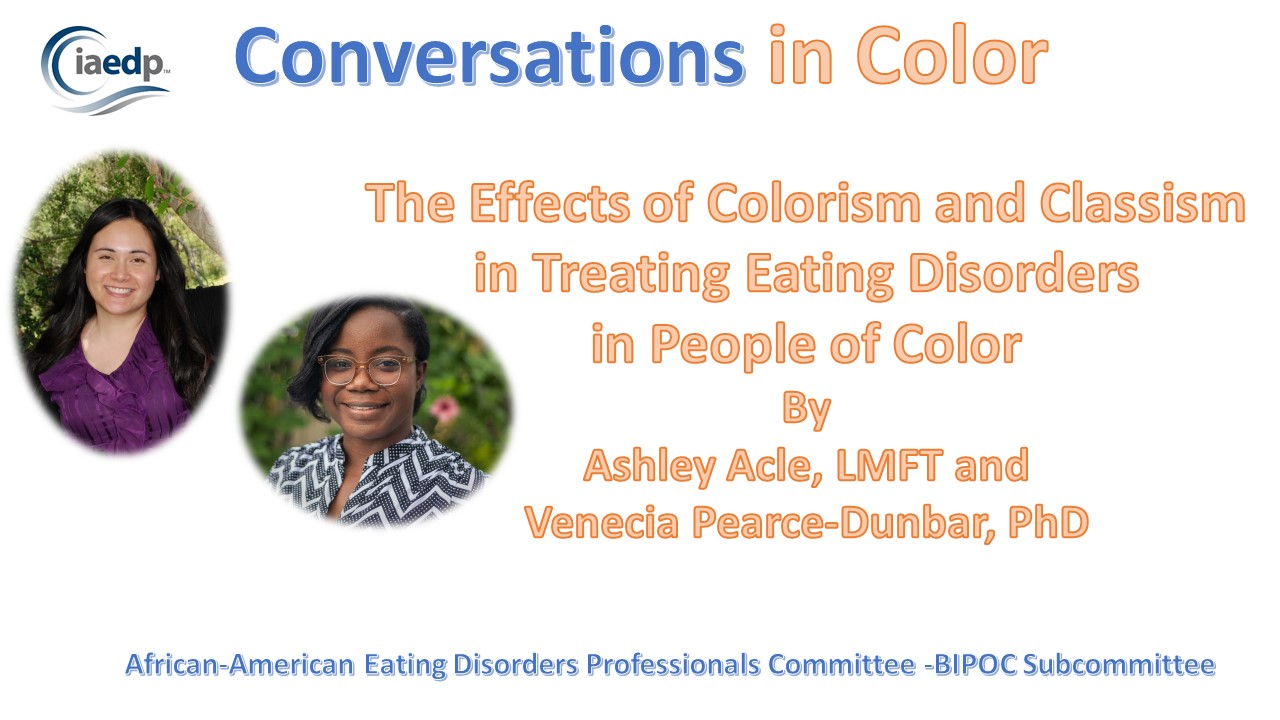Conversations in Color – July 2020
The Effects of Colorism and Classism in Treating Eating Disorders in People of Color
By Ashley Acle, LMFT and Venecia Pearce-Dunbar, PhD
In the US, colorism is a distinct and simultaneously intertwined experience to racism, closely tied to our historical sociopolitical experiences of slavery and colonization. It is an area of limited focus in research and clinical practice, though impactful. For example, studies of colorism among African American participants with light, medium and dark skin tones have revealed that reactions to colorist incidents, often considered traumatic, include suicidal behavior (Perry, Stevens Watkins, & Oser, 2013), and appearance-altering behavior (Glenn, 2008). A lack of belonging is also noted resulting in avoidance and isolation, particularly among lighter-skinned women and men who report feeling stigmatized within their racial/ethnic community (Hunter, 2008; Rockquemore, 2002). Skin color has also been found to impact more global health outcomes among African American women, with the most physiological deterioration noted among medium- and dark-skinned women relative to their light-skinned counterparts (Hargrove, 2019). The impact of colorism among other racial and ethnic groups in the US is unclear, though likely, as experiences of colorism are also noted among participants in Asia (e.g. Bettache, 2020) and Latin America (e.g. Dixon, 2019). These combined findings have consequential effects on the well-being of Black, Indigenous and People of Color (BIPOC), highlighting the need for better understanding the psychological and physical effects of colorism. It is important that we learn to better assess, discuss and intervene in colorist incidents given implications for the well-being of clients and participants.
As the world protests against racial and systemic injustices, several debates have been ignited on whether racism exists in Jamaica. Predominantly a population with people of African descent, racial consciousness has long been a less prominent discussion. Jamaica’s motto ‘Out of many one people’ seeks to project racial harmony as Jamaicans are also members of the White, Asian, Indian races and in-between. As such, the blatant racism that has led to the uprising of the ‘Black Lives Matter movement’ is not as flagrant on the sandy shores. Many Jamaicans may never experience racism as African Americans do if they do not leave the island. However, one thing that is sure in the Jamaican black experience is color prejudice (which some may argue is a form of racism). The footprints of slavery and colonialism have no doubt left a mark on the Jamaican society which manifests in classism and colorism to the present generation. The historical sociocultural context of colorism and classism in Jamaica also presents an analogy for examining these constructs in the US. To further examine the effects of colorism and classism, we offer perspectives on these topics from Jamaica and the US as an invitation to continue the conversation and your own critical thinking about these topics.
With a lighter skin colour for instance in the Jamaican context, the idea is that better opportunities and social mobility abound. The notion that white equals wealth and privilege compared to blacks as poor and manual labourers and the interbreeding of the two, results in a range of attitudes toward people with light or dark-colored skin (Morgan & O’Garo, 2008). The privilege of the white and brown-skinned then, has been argued as one of the main causes of skin bleaching in Jamaica (Morgan & O’Garo, 2008; Charles, 2003). Similar practices of skin bleaching have been found in the US among African and Afro-Carribean women and Mexican-American men and women. It is likely that these practices are more widespread than these populations, given the global industry of skin lightening and fairness creams in other regions, including the Middle East (e.g. Alrayyes, 2019). The degradation of the Afrocentric identity and promulgation of the Eurocentric/western ideal place Jamaicans, Caribbean nationals, African Americans and people with African ancestry at risk for eating disorders and other psychopathologies. An integrated, multi-disciplinary and culturally sensitive approach is recommended to address the stigma and seriousness of skin bleaching as a complex public health concern (Benn et al., 2016). Eating Disorder treatment professionals and researchers should be well equipped to be part of these collaborative teams.
Similarly, the privilege that comes with certain sections/classes of the society should not be ignored. Colorism and classism have been, and to an extent remain, closely related as those with social and financial means avoid manual labor that requires hours in the sun. In Jamaica, business ownerships are dominated by wealthy Whites or Chinese. One’s address also has the potential to block access to certain jobs and opportunities, especially if one resides in an area dubbed the ‘ghetto’ or low income communities (Jamaica Gleaner, 2010). A similar history and pattern of privileging certain classes is found in the US, with class impacting one’s experiences of psychological distress driven by anxiety and adverse life experiences, access to healthcare, quality of education, morbidity and premature mortality, among other factors (Engelgau et al., 2019).
As we continue to address racial and systemic injustices, it’s important that we take stock of the effects of colorism and classism in treating eating disorders in people of color. Additional knowledge is needed for addressing the psychological risk associated with these factors. This is challenging given the lack of attention to colorism in the field “as most psychologists (and researchers) have not been educated or trained to recognize and acknowledge skin-tone trauma” (Landor and McNeil Smith, 2019). We offer some guidelines, informed by the work of Antoinette Landor, that include acknowledging that colorism exists (e.g. at the individual, institutional and cultural levels) and having difficult conversations about the implications of colorism (e.g. who is privileged, who is oppressed). Clinicians and researchers would also be prudent to consider the use of language, specifically in defining words that capture colorist experiences and to reduce the likelihood of replicating colorism related trauma. Believing others when they are open about experiences, without denying their experience or becoming defensive, is also important. Unfortunately, minimal guidelines have been identified in addressing the effects of classism given the low focus on this topic in the literature.
We end with some questions for reflection to move towards more equitable clinical and research practices: Do our diagnostic tools and assessments support the recognition of skin color related experiences and trauma? Are we aware of and addressing how race, skin tone, and class impact who has access to ED care? Lastly, how do we build a climate in eating disorders that allows the honest identification of implicit bias related to skin tone, class, and race while supporting solidarity with those who have been marginalized? We are hopeful that honest conversations about these and related topics can support changes to better serve our marginalized populations in need.
References
Alrayyes, S. F., Alrayyes, S. F., & Farooq, U. D. (2019). Skin-lightening patterns among female students: A cross-sectional study in Saudi Arabia. International Journal of Women’s Dermatology, 5(4), 246–250. https://doi.org/10.1016/j.ijwd.2019.04.026
Benn, E. K. T., Alexis, A., Mohamed, N., Wang, Y.-H., Khan, I. A., & Liu, B. (2016). Skin Bleaching and Dermatologic Health of African and Afro-Caribbean Populations in the US: New Directions for Methodologically Rigorous, Multidisciplinary, and Culturally Sensitive Research. Dermatology and Therapy, 6(4), 453–459. https://doi.org/10.1007/s13555-016-0154-1
Bettache, K. (2020). A Call to Action: The Need for a Cultural Psychological Approach to Discrimination on the Basis of Skin Color in Asia. Perspectives on Psychological Science, 15(4), 1131–1139. https://doi.org/10.1177/1745691620904740
Charles, C. A. D, (2003). Skin bleaching, self-hate and black identity in Jamaica. Journal of Black Studies, 33(6), 711-728. https://doi.org/10.1177/0021934703033006001
Dixon, A. R. (2019). Colorism and classism confounded: Perceptions of discrimination in Latin America. Social Science Research, 79, 32–55. https://doi.org/10.1016/j.ssresearch.2018.12.019
Engelgau, M. M., Zhang, P., Jan, S., & Mahal, A. (2019). Economic Dimensions of Health Inequities: The Role of Implementation Research. Ethnicity & Disease, 29(Suppl 1), 103–112. https://doi.org/10.18865/ed.29.S1.103
Glenn, E. N. (2008). Yearning for lightness: Transnational circuits in the marketing and consumption of skin lighteners. Gender & Society, 22, 281–302. https://doi.org/10.1177/0891243208316089
Hargrove, T. W. (2019). Light Privilege? Skin Tone Stratification in Health among African Americans. Sociology of Race and Ethnicity (Thousand Oaks, Calif.), 5(3), 370–387. https://doi.org/10.1177/2332649218793670
Hunter, M. (2008). The cost of color: What we pay for being black and brown. In R. E. Hall (Ed.), Racism in the 21st century (pp. 63–76). New York, NY: Springer
Jamaica Gleaner (2010). Wrong address – Many Jamaicans still denied jobs and services because of where they live. Retrieved July 2020 from http://jamaica-gleaner.com/gleaner/20100307/lead/lead9.html
Landor, A. M., & McNeil Smith, S. (2019). Skin-Tone Trauma: Historical and Contemporary Influences on the Health and Interpersonal Outcomes of African Americans. Perspectives on Psychological Science, 14(5), 797–815. https://doi.org/10.1177/1745691619851781
Morgan, K., & O’Garo, K. (2008) Caribbean identity issues. In Hickling, F. W., Matthies, B. K., Morgan, K., & Gibson, R. C. (Ed). Perspectives in Caribbean Psychology. CARIMENSA, University of the West Indies, Mona
Perry, B. L., Stevens-Watkins, D., & Oser, C. B. (2013). The moderating effects of skin color and ethnic identity affirmation on suicide risk among low-SES African American women. Race and Social Problems, 5, 1–14. https://doi.org/10.1007/s12552-012-9080-8
Rockquemore, K. A. (2002). Negotiating the color line: The gendered process of racial identity construction among black/white biracial women. Gender & Society, 16, 485– 503. https://doi.org/10.1177/0891243202016004005
Ashley Acle, LMFT and currently the California Regional Compliance Manager for Alsana: An Eating Recovery Community. Her research and clinical interests include eating disorders, suicidality and emotional expression and the influence of contextual factors on these presentations. Ashley is passionate about integrating culture in mental health, specifically in the treatment of eating disorders among ethnic and racial minorities, and has brought this unique perspective in to her previous roles as Director of Clinical Services and Program Director. She has worked with diverse individuals, families and couples struggling with suicidality, acute psychosis, homicidality, eating disorders, mood disorders and co-occurring relational distress for the last 10 years. Ashley is committed to increasing access to quality mental health care for underserved populations using technology and increased community awareness.
Ashley completed her B.A. at Swarthmore College and her Master of Family Therapy at Drexel University. Ashley has presented at several conferences and in the community on mental health and eating disorders. She is a member of the Northern California Community for Emotionally Focused Therapy (NCCEFT) and California Association of Marriage and Family Therapists (CAMFT). Contact: ashley.acle@gmail.com
Venecia Pearce-Dunbar, B.Sc (Hons); M.Sc, PhD is a Jamaican, a research psychologist and lecturer in psychology in the department of Sociology, Psychology and Social work at the University of the West Indies, Mona. She’s a graduate of the University of the West Indies, Mona where she received her B.Sc in Psychology and M.Sc in Applied Psychology. Venecia completed her doctoral studies at Brunel University London in the United Kingdom. Her research interests include body weight perceptions, perceptions of fluffy women, cultural differences in weight perception, body image, social media, eating disorders and health enhancing behaviours – specifically, physical activity. She’s an advocate for healthy living at any size and reducing weight stigma. She currently teaches social psychology, interpersonal and group dynamics, research and other related courses. She also supervises undergraduate and graduate research projects. She’s an author and presents at several conferences locally and overseas. She is currently a member of the iaedp International Chapter in Jamaica. Contact: venecia.pearce@gmail.com
*The opinions and views of our guest contributors are shared to provide a broad perspective of eating disorders and not intended as endorsement by iaedp Foundation, Inc. or its Board of Directors.*






